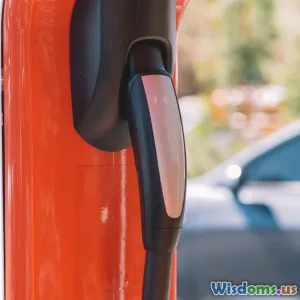
Why Are Wireless Charging Roads Still Rare in 2024
7 min read Explore the challenges and realities behind the rarity of wireless charging roads in 2024. (0 Reviews)
Why Are Wireless Charging Roads Still Rare in 2024?
Imagine a future where electric vehicles (EVs) never need to be plugged in — roads wirelessly charge them as they drive. This vision promises a revolution in transportation, alleviating range anxiety and accelerating the green energy transition. Yet, despite the excitement and several pilots worldwide, wireless charging roads remain a rarity in 2024. What factors hold back this compelling technology from becoming mainstream? This article delves into the technical, economic, regulatory, and infrastructural hurdles preventing widescale deployment of wireless charging roads.
Understanding Wireless Charging Roads
Wireless charging roads, also known as dynamic wireless power transfer (DWPT), use embedded coils within the road infrastructure to transmit electrical energy via electromagnetic fields to compatible vehicles traveling overhead. Unlike static charging pads that require a vehicle to stop over a charger, DWPT enables EVs to continuously recharge while in motion.
Current Examples
- South Korea: KEPCO and Hyundai piloted a wireless charging segment on a highway stretching several kilometers near Incheon.
- Sweden: The Electricroad project tested a 2-kilometer stretch embedded with charging coils.
Despite many successful prototypes, public wireless charging roads are extremely limited in scale.
Challenges Holding Wireless Charging Roads Back
1. Massive Infrastructure Costs
Building wireless charging into roads demands extensive engineering — embedding coils beneath heavy asphalt or concrete surfaces involves significant excavation, reconstruction, and specialized materials.
- High capital expenditure: Initial costs can be several million dollars per kilometer.
- Maintenance expenses: Road embedded electronics must withstand weather, traffic loads, and wear, which drive up ongoing costs.
For cash-strapped governments and transport agencies, such investments appear risky without clear demonstrated ROI.
2. Technical Complexity and Efficiency Issues
Wireless power transfer efficiency is lower compared to wired fast charging — current dynamic systems can only transfer power at modest rates (typically under 20 kW), which may not suffice to maintain or significantly increase EV battery charge at typical highway speeds.
- Energy losses: Roughly 10–20% energy loss occurs during transmission, increasing operational costs.
- Alignment challenges: Vehicles must maintain close proximity and alignment to coils underground, which varies with lane position and car design.
These technological limitations slow adoption, as current EV batteries and power demands require faster, more reliable charging methods.
3. Lack of Industry Standards and Compatibility
Wireless charging roads require both infrastructure and vehicles with compatible charging receivers. Yet, there is no universally accepted global standard for dynamic wireless charging.
- Varied protocols: Different projects use proprietary technology for power transmission and communication.
- Slow vehicle integration: Most EV manufacturers focus on static surface chargers and have yet to integrate or invest in compatible DWPT receiving systems.
Without broad industry cooperation, widespread adoption stalls.
4. Regulatory and Safety Concerns
Electromagnetic fields generated by wireless charging raise concerns about safety for humans and interference with electronic devices.
- Long-term exposure and environmental impact studies are incomplete.
- Regulatory approvals delay deployment since agencies require comprehensive tests and certifications.
These concerns call for thorough investigation before mass rollout.
5. Competing Technologies and Infrastructure Priorities
As EV fast charging stations proliferate with financing focused on gigawatt-scale DC fast charging network expansions, wireless charging roads must compete for limited funding.
Meanwhile, improvements in battery capacity and charging speed reduce urgency for in-motion charging solutions.
For many planners, investing in traditional charging stations or vehicle-to-grid (V2G) technology proves more practical.
Potential Pathways to Overcome Barriers
Technological Innovation
Researchers continually push for higher efficiency materials, adaptive coil designs for better alignment tolerance, and advanced power electronics.
For instance, KAIST’s prototype enhanced transfer efficiency above 90% in lab conditions, showing promise for feasible scaling.
Public-Private Partnerships
Collaborations involving government funding, industry players, and utilities can share risks of infrastructure investments. South Korea's government-led program exemplifies this model.
Pilot Programs and Data Collection
Expanding real-world pilot projects helps build datasets on technical reliability, cost-benefit ratios, and public acceptance — crucial to attract private and government funding.
Standardization Efforts
Groups like SAE International work toward protocols for wireless EV charging systems to ensure interoperability and foster industry confidence.
Conclusion
The vision of wireless charging roads transforming how electric vehicles power themselves on the go remains compelling in 2024. Yet, steep infrastructure costs, technical inefficiencies, regulatory hurdles, and competing charging paradigms limit widespread deployment. Continued research, pilot programs, standardization, and strategic partnerships will be key for overcoming these complex barriers.
While the landscape may evolve rapidly, today's wireless charging roads are mainly experimental precursors rather than the norm. The future of truly wireless charging highways hinges not just on innovation but the alignment of economics, technology, and policy to tip the scales toward feasibility and mass adoption.
Until then, the dream of endlessly cruising without plugging in remains tantalizingly on the horizon.
By understanding these factors, stakeholders can better navigate the challenges ahead, and readers gain insight into when and why this flashy technology may finally become a road reality.
Rate the Post
User Reviews
Popular Posts




















